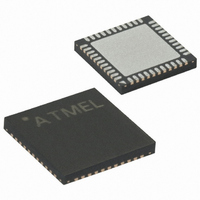ATMEGA162V-1MC Atmel, ATMEGA162V-1MC Datasheet - Page 107

ATMEGA162V-1MC
Manufacturer Part Number
ATMEGA162V-1MC
Description
IC MCU AVR 16K 1.8V 8MHZ 44-QFN
Manufacturer
Atmel
Series
AVR® ATmegar
Specifications of ATMEGA162V-1MC
Core Processor
AVR
Core Size
8-Bit
Speed
1MHz
Connectivity
EBI/EMI, SPI, UART/USART
Peripherals
Brown-out Detect/Reset, POR, PWM, WDT
Number Of I /o
35
Program Memory Size
16KB (8K x 16)
Program Memory Type
FLASH
Eeprom Size
512 x 8
Ram Size
1K x 8
Voltage - Supply (vcc/vdd)
1.8 V ~ 3.6 V
Oscillator Type
Internal
Operating Temperature
0°C ~ 70°C
Package / Case
44-VQFN Exposed Pad
Lead Free Status / RoHS Status
Contains lead / RoHS non-compliant
Data Converters
-
- Current page: 107 of 289
- Download datasheet (3Mb)
Accessing 16-bit
Registers
2513C–AVR–09/02
The TCNTn, OCRnA/B, and ICRn are 16-bit registers that can be accessed by the AVR
CPU via the 8-bit data bus. The 16-bit register must be byte accessed using two read or
write operations. Each 16-bit timer has a single 8-bit register for temporary storing of the
high byte of the 16-bit access. The same Temporary Register is shared between all 16-
bit registers within each 16-bit timer. Accessing the low byte triggers the 16-bit read or
write operation. When the low byte of a 16-bit register is written by the CPU, the high
byte stored in the temporary register, and the low byte written are both copied into the
16-bit register in the same clock cycle. When the low byte of a 16-bit register is read by
the CPU, the high byte of the 16-bit register is copied into the temporary register in the
same clock cycle as the low byte is read.
Not all 16-bit accesses uses the temporary register for the high byte. Reading the
OCRnA/B 16-bit registers does not involve using the temporary register.
To do a 16-bit write, the high byte must be written before the low byte. For a 16-bit read,
the low byte must be read before the high byte.
The following code examples show how to access the 16-bit Timer Registers assuming
that no interrupts updates the temporary register. The same principle can be used
directly for accessing the OCRnA/B and ICRn Registers. Note that when using “C”, the
compiler handles the 16-bit access.
Note:
The assembly code example returns the TCNTn value in the r17:r16 register pair.
It is important to notice that accessing 16-bit registers are atomic operations. If an inter-
rupt occurs between the two instructions accessing the 16-bit register, and the interrupt
code updates the temporary register by accessing the same or any other of the 16-bit
Timer Registers, then the result of the access outside the interrupt will be corrupted.
Assembly Code Examples
C Code Examples
...
; Set TCNTn to 0x01FF
ldi r17,0x01
ldi r16,0xFF
out TCNTnH,r17
out TCNTnL,r16
; Read TCNTn into r17:r16
in
in
...
unsigned int i;
...
/* Set TCNTn to 0x01FF */
TCNTn = 0x1FF;
/* Read TCNTn into i */
i = TCNTn;
...
1. The example code assumes that the part specific header file is included.
For I/O Registers located in extended I/O map, “IN”, “OUT”, “SBIS”, “SBIC”, “CBI”,
and “SBI” instructions must be replaced with instructions that allow access to
extended I/O. Typically “LDS” and “STS” combined with “SBRS”, “SBRC”, “SBR”, and
“CBR”.
r16,TCNTnL
r17,TCNTnH
(1)
(1)
ATmega162(V/U/L)
107
Related parts for ATMEGA162V-1MC
Image
Part Number
Description
Manufacturer
Datasheet
Request
R

Part Number:
Description:
Manufacturer:
Atmel Corporation
Datasheet:

Part Number:
Description:
IC AVR MCU 16K 16MHZ 5V 44TQFP
Manufacturer:
Atmel
Datasheet:

Part Number:
Description:
IC AVR MCU 16K 16MHZ 5V 40DIP
Manufacturer:
Atmel
Datasheet:

Part Number:
Description:
IC AVR MCU 16K 16MHZ 5V 44-QFN
Manufacturer:
Atmel
Datasheet:

Part Number:
Description:
IC MCU AVR 16K 5V 16MHZ 44-TQFP
Manufacturer:
Atmel
Datasheet:

Part Number:
Description:
IC MCU AVR 16K 5V 16MHZ 44-QFN
Manufacturer:
Atmel
Datasheet:

Part Number:
Description:
MCU AVR 16KB FLASH 16MHZ 44QFN
Manufacturer:
Atmel
Datasheet:

Part Number:
Description:
MCU AVR 16KB FLASH 16MHZ 44TQFP
Manufacturer:
Atmel
Datasheet:

Part Number:
Description:
IC MCU AVR 16K 5V 16MHZ 44-TQFP
Manufacturer:
Atmel
Datasheet:

Part Number:
Description:
IC MCU AVR 16K 5V 16MHZ 44-QFN
Manufacturer:
Atmel
Datasheet:

Part Number:
Description:
IC MCU AVR 16K 5V 16MHZ 40-DIP
Manufacturer:
Atmel
Datasheet:

Part Number:
Description:
IC MCU AVR 16K 5V 16MHZ 40-DIP
Manufacturer:
Atmel
Datasheet:

Part Number:
Description:
IC MCU AVR 16K 5V 16MHZ 44-TQFP
Manufacturer:
Atmel
Datasheet:










